House (O. Eng. hús, a word common to Teutonic languages, cf. Dut. huis, Ger. Haus; in Gothic it is only found in gudhûs, a temple; it may be ultimately connected with the root of “hide,” conceal), the dwelling-place of a human being (treated, from the architectural point of view, below), or, in a transferred sense, of an animal, particularly of one whose abode, like that of the beaver, is built by the animal itself, or, like that of the snail, resembles in some fancied way a human dwelling. Apart from the numerous compound uses of the word, denoting the purpose for which a building is employed, such as custom-house, lighthouse, bakehouse, greenhouse and the like, there may be mentioned the particular applications to a chamber of a legislative body, the Houses of Parliament, House of Representatives, &c.; to the upper and lower assemblies of convocation; and to the colleges at a university; the heads of these foundations, known particularly as master, principal, president, provost, rector, &c., are collectively called heads of houses. At English public schools a “house” is the usual unit of the organization. In the “houses” the boys sleep, have their “studies” and their meals, if the school is arranged on the “boarding-house” system. The houses have their representative teams in the school games, but have no place in the educational class-system of the school. It may be noticed that in Scotland the words “house” and “tenement” are used in a way distinct from the English use, “tenement” being applied to the large block containing “houses,” portions, i.e., occupied by separate families. “The House” is the name colloquially given to such different institutions as the London Stock Exchange, the House of Commons or Lords and to a workhouse.
In the transferred sense, “house” is used of a family, genealogically considered, and of the audience at a public meeting or entertainment, especially of a theatre. A “house-physician” and “house-surgeon” is a member of the resident medical staff of a hospital. In astrology the twelve divisions into which the heavens are divided, and through which the planets pass, are known as houses, the first being called the “house of life.” The word “house,” “housing,” used of the trappings of a horse, especially of a covering for the back and flanks, attached to the saddle, is of quite distinct origin. In medieval Latin it appears as hucia, houssia and housia (see Ducange, Glossarium, s.v. housia), and comes into English from the O. Fr. huche, modern housse. It has been supposed to have been adopted, at the time of the crusades, from the Arabic yushiah, a covering.
Architecturally considered, the term “house” is given to a building erected for habitation, in contradistinction to one built for secular or ecclesiastical purposes. The term extends, therefore, to a dwelling of any size, from a single-room building to one containing as many rooms as a palace; thus in London some of the largest dwellings are those inhabited by royalty, such as Marlborough House, or others by men of rank, such as Devonshire House, Bridgewater House, Spencer House, &c.; and even those which, formerly built as habitations, have subsequently been devoted to other purposes, such as Somerset House and Burlington House, retain the term. In Paris the larger houses thus named would be called hôtel.
So far as the history of domestic architecture is concerned, the earliest houses of which remains have been found are those of the village of Kahun in Egypt, which were built for the workmen employed in the building of the pyramid at Illahun, and deserted on its completion. They varied in size from the habitations of the chief inspectors to the single room of the ordinary labourer, and were built in unburnt brick with open courts in the larger examples, to give light and air to the rooms round. The models found in 1907 at Deir-Rifa opposite Assiut in Upper Egypt, by Flinders Petrie, and assumed by him to be those of “soul-houses,” suggest that the early type of building consisted of a hut, to which later a porch or lean-to, with two poles in front, has been added; subsequently, columns replaced the poles, and a flat roof with parapet, suggesting the primitive forms of the Egyptian temple.
The only remains of early houses found in Mesopotamia are those within the precincts of the Temple of Bel, at Nippur, occupied by the king; but beyond the fact that the walls were built in unburnt brick and were sometimes of great thickness, nothing is known.
The houses in Crete would seem to have been small in area, but this was compensated for in height, as the small plaques found in the palace at Cnossus show houses in two or three storeys, with gable roofs and windows subdivided by mullions and transomes, corresponding with those of the 15th to 17th centuries in England. The stone staircase in the palace rising through two storeys shows that even at this early period the houses in towns had floors superposed one above the other; to a certain extent the same extension existed in the later Greek houses found in Delos, in two of which there was clear evidence of wooden staircases leading within to the roof or to an upper storey. The largest series hitherto discovered is that at Priene in Asia Minor, where the remains of some thirty examples were found, varying in dimensions, but all based on the same plan; this consisted of an entrance passage leading to an open court, on the north side of which, and therefore facing south, was an open portico, corresponding to the prostas in Vitruvius (vi. 7), and in the rear two large rooms, one of which might be the oecus or sitting-room, and the other the thalamos or chief bedroom. Other rooms round the court were the triclinium, or dining room, and cubicula or bedchambers. The largest of these houses occupied an area measuring 75 × 30 ft. Those found in Delos, though fewer in number, are of much greater importance, the house in the street of the theatre having twelve rooms exclusive of the entrance passage and the great central court, surrounded on all four sides by a peristyle; in this house the oecus measured 26 × 18 ft. In a second example the prostas consisted of a long gallery, the whole width of the site, which was lighted by windows at each end, the sills of which were raised 8 ft. or 9 ft. from the floor.
Plate II.
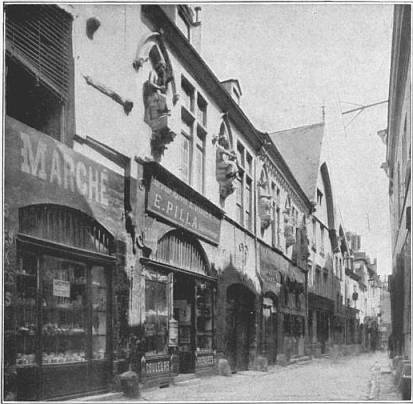 |
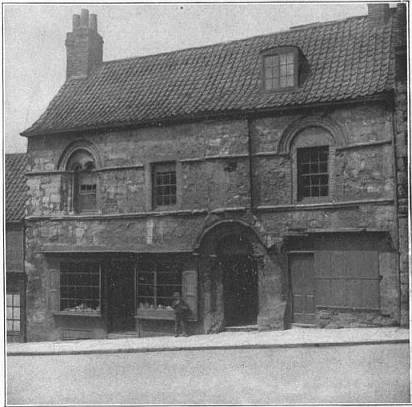 |
| Photo, Neurdein. | Photo, F. Frith & Co. |
| Fig. 4.—MUSICIAN’S HOUSE, REIMS. | Fig. 5.—JEW’S HOUSE, LINCOLN. |
 |
| Photo, Neurdein. |
| Fig. 6.—HÔTEL DE CLUNY, PARIS. |
Plate II.
 |
| Photo, Neurdein. |
| Fig. 7.—HÔTEL DE JACQUES CŒUR, BOURGES, FAÇADE. |
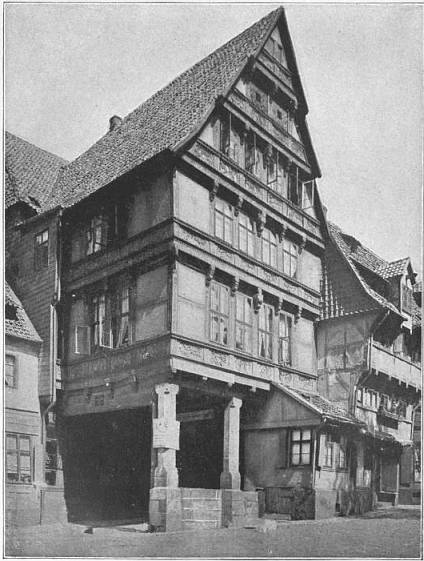 |
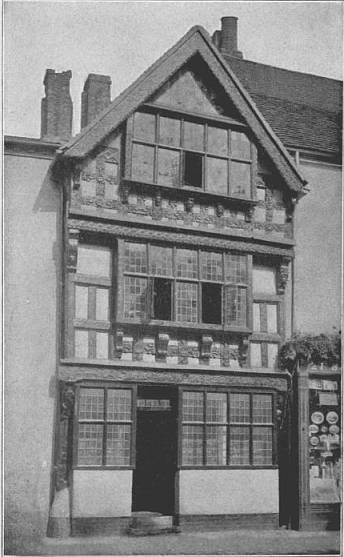 |
| Photo. F. Frith & Co. | |
| Fig. 8.—HALF-TIMBERED HOUSE AT HILDESHEIM. | Fig. 9.—HOUSE OF JOHN HARVARD’S MOTHER, STRATFORD-ON-AVON. |
The remains of the houses found in the Peiraeus are of the same simple plan as those at Priene, and suggest that the Greek house was considered to be the private residence only for the members of the family, and without any provision for entertaining guests as in Rome and Pompeii. From the descriptions given by Vitruvius (ii. 8) it may be gathered that in his time many of the houses in Rome were built in unburnt brick, the walls of which, if properly protected at the top with a course of burnt brick projecting over the face of the brickwork, and coated inside and outside with stucco, were considered to be more lasting than those built in soft stone. Vitruvius refers also to Greek houses thus built, and states that in the house of Mausolus, at Halicarnassus, the walls were of unburnt brick, and the plastering with which they were covered was so polished that they sparkled like glass. In Rome, however, he points out, such walls ought to be forbidden, as they are not fit to carry an upper storey, unless they are of great thickness, and as upper storeys become necessary in a crowded city such walls would occupy too much space. The houses in Pompeii (q.v.) were built in rubble masonry with clay mortar, and their walls were protected at the top by burnt brick courses and their faces with stucco; they were, however, of a second- or third-rate class compared with those in Rome, the magnificence of which is attested in the descriptions given by various writers and substantiated by the remains occasionally found in excavations. Vitruvius refers to upper storeys, which were necessary in consequence of the limited area in Rome, and representations in mosaic floors and in bas-relief sculpture have been found on which two or three storeys are indicated. The plans of many Roman houses are shown on the Marble Plan, and they resemble those of Pompeii, but it is probable that the principal reception rooms were on an upper storey, long since destroyed. The house of Livia on the Palatine Hill was in two storeys, and the decoration was of a much finer character than those of Pompeii; this house and the House of the Vestals might be taken as representative of the Roman house in Rome itself. In those built in colder climates, as in England and Germany, account has to be taken of the special provision required for warming the rooms by hypocausts, of which numerous examples have been found, with rich mosaic floors over them.
Of the houses in succeeding centuries, those found in the cities of central Syria, described in the article Architecture, are wonderfully perfect, in consequence of their desertion at the time of the Mahommedan invasion in the 7th century. Very little is known of the houses in Europe during the dark ages, owing to the fact that they were generally built in wood, with thatched roofs. The only examples in stone which have been preserved are those in the island of Skellig Michael, Kerry, which were constructed like the beehive tombs at Mycenae with stone courses overlapping inside until they closed in at the top. These houses or cells were rectangular inside and round or oval outside, with a small low door at one end, and an opening above to let the smoke out.
The houses, even in large towns like London, were built mainly in wood, in some cases down to the 17th century; in the country, the smaller houses were constructed with trunks of trees in pairs, one end of the trunk being sunk in the ground, the other bent over and secured by a ridge piece, thus forming a pointed arch, the opening of which was about 11 ft. The pairs were fixed 16 ft. apart, and the space included constituted a bay, any requisite increase in the size of the house being made by doubling or trebling the bays. The roofs were thatched with straw on battens, and sometimes with a collar beam carrying a floor, which constituted an upper storey. The end walls were closed with wooden studs and wattle-and-daub filling. The pairs of trees were known as forks or crucks. Vitruvius (ii. 1) suggests a similar kind of building in ancient times, except that the interlaced twigs were covered with clay, so as to carry off the rain. In Yorkshire there was another type of house, known as a coit, which was a dwelling-house and barn (shippon) united; the latter contained the cow-stalls with loft above, and the former was in two storeys, with a ladder inside the room leading to the upper floor.1
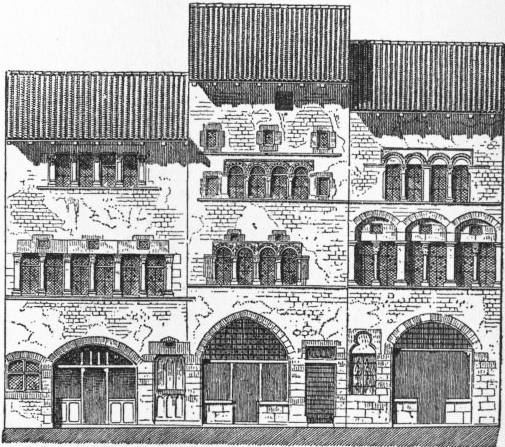 |
| Fig. 1.—Houses at Cluny. |
Passing now to structures of a less ephemeral character, the earliest houses of which there still remain substantial relics are those built in stone (see Manor House). The Jew’s House at Lincoln, 12th century, is one of the best-known examples, and still preserves its street front in stone, with rich entrance doorway and first-floor windows lighting the principal room, which seems invariably in those early houses to have been on the first floor, the ground floor being used for service and stores (see Plate I. fig. 5). To the 13th century belongs the old Rectory House at West Dean, Sussex, and to the 14th century the Parsonage House at Market Deeping, Lincolnshire. The principal examples of the domestic architecture of this early period in the country are castles, manor houses and farm buildings, as town houses occupied sites too valuable to be left untouched; this, however, is not the case in France, and particularly in the south, where streets of early houses are still to be found in good preservation, such as those at Cluny (fig. 1) and Cordes (Tarn), and others at Montferrand, Cahors, Figeac, Angers, Provins, Sarlat (fig. 2), St Emilion, Périgueux, Soissons and Beauvais, dating from the 12th to the 14th centuries. One of the most remarkable examples is the Musician’s House at Reims (see Plate I., fig. 4), with large windows on the first floor, between which are niches with life-size figures of musicians seated in them. Generally speaking, the ground storeys of these houses, which in many cases were occupied by shops, have been transformed, but occasionally the old shop fronts remain, as in Dinan, Morlaix and other old towns in Brittany. Houses of the first Renaissance of great beauty exist in Orleans, such as the house of Agnes Sorel; and the example in the Market Place illustrated in fig. 3; in Tours, Tristan’s house in brick with stone quoins and dressings to windows; in Rouen, Caen, Bayeux, Toulouse, Dijon and, in fact, in almost every town throughout France. Of houses of large dimensions, which in France are termed hôtels, there are also many other fine examples, the best known of which are the hôtel de Jacques Cœur (see Plate II., fig. 7), at Bourges, and the hôtel de Cluny at Paris (see Plate I., fig. 6). In the 15th and 16th centuries in France, owing to the value of the sites in towns, the houses rose to many storeys, the upper of which were built in half-timber, sometimes projecting on corbels and richly carved; of these numerous examples exist at Rouen, Beauvais, Bayeux and other towns in Normandy and Brittany. Of such structures in English towns (see Plate II. fig. 9) there are still preserved some examples in York, Southampton, Chester, Shrewsbury, Stratford-on-Avon, and many smaller towns; the greatest development in half-timber houses in England is that which is found more particularly throughout Kent, Sussex and Surrey, in houses of modest dimensions, generally consisting of ground and first floor only, with sometimes additional rooms in the roof; in these the upper storey invariably projects in front of the lower, giving increased dimensions to the rooms in the former, but adopted in order to protect the walls of the ground storey from rain, which in the upper storey was effected by the projecting eaves of the roof. In the north and west of England, where stone could be obtained at less cost than brick, and in the east of England, where brick, often imported from the Low Countries, was largely employed, the ordinary houses were built in those materials, and in consequence of their excellent construction many houses of the 16th and 17th centuries have remained in good preservation down to the present day; they are found in the Cotswolds generally, and (among small towns) at Broadway in Worcestershire and (of brick) throughout Essex and Suffolk. Among the larger half-timber houses built in the 15th and 16th centuries, mention may be made of Bramhall Hall, near Manchester; Speke Hall, near Liverpool (see Plate III., fig. 10); The Oaks; West Bromwich; and Moreton Old Hall, Cheshire, one of the most elaborate of the series (see Plate III., fig. 11).
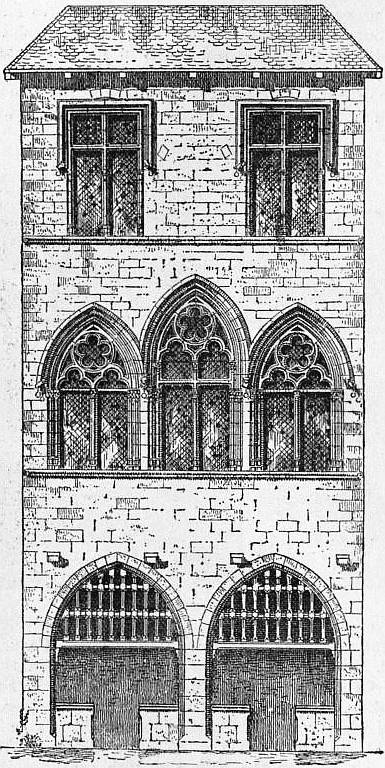 |
| Fig. 2.—House at Sarlat. |
On the borders of the Rhine, as at Bacharach and Rhense, and throughout Germany, hall-timber houses of the most picturesque character are found in every town, large and small, those of Hildesheim (see Plate II., fig. 8) dating from the 15th and 16th centuries, and in some cases rising to a great height with four or five storeys, not including those in the lofty roofs. Houses in stone from the 12th to the 16th century are found in Cologne, Metz, Trier, Hanover and Münster in Westphalia, where again there are whole streets remaining; and in brick at Rostock, Stralsund, Lübeck, Greifswald and Dantzig, forming a very remarkable series of 15th and 16th-century work.
Of half-timber work in Italy there are no examples, but sometimes (as at Bologna) the rooms of the upper floors are carried on arcades, and sometimes on corbels, as the casa dei Carracci in the same town. The principal feature of the Italian house is the courtyard in the rear, with arcades on one or more sides, the front in stone or brick, or both combined, being of the greatest simplicity (examples in San Gimignano and Pisa). At Viterbo are small houses in stone, two of which have external stone staircases of fine design, and the few windows on the ground floor suggest that the rooms there were used only for stores. Houses with external staircases, but without any architectural pretensions, are found throughout the Balkan provinces.
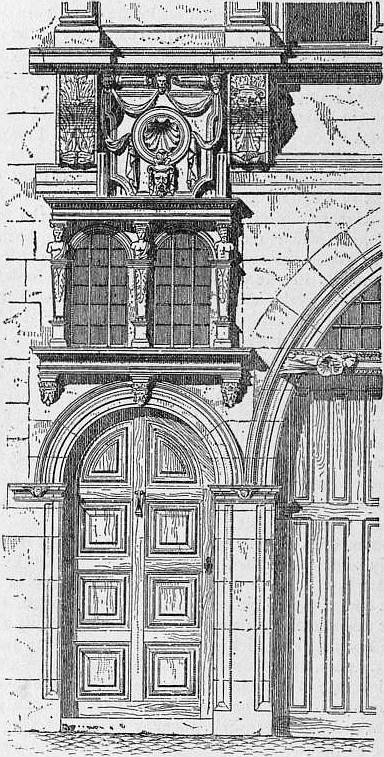 |
| Fig. 3.—Detail of house at Orleans. |
The introduction of the purer Italian style into England in the 17th century created a great change in domestic architecture. Instead of the projecting wings and otherwise picturesque contour of the earlier work the houses were made square or rectangular on plan, in two or three storeys, crowned with a modillion cornice carrying a roof of red tiles; the only embellishments of the main front were the projecting courses of stone on the quoins and architraves round the windows, and flat pilasters carrying a hood or pediment flanking the entrance doorway. In the larger mansions more thought was bestowed on the introduction of porticoes (scarcely necessary in the English climate), with sometimes great flights of steps up to the principal floor, which was raised above a basement with cold and dark passages; a great saloon in the centre of the block, lighted from above, took the place of the great entrance hall of the Tudor period, and the rooms frequently led one out of the other, without an independent entrance door. On the other hand, in the ordinary houses, the deficiency in external ornament was amply made up for by the comfort in the interior and the decoration of the staircase and other rooms. Towards the close of the century the square mullioned and transomed windows, with opening casements, gave way to sash windows, introduced from Holland, and these with moulded and stout sash-bars gave a certain character to the outside of the houses, which are valued now for their quiet unpretentious character and excellent construction. In the closes of many English cathedrals, on the outskirts of London, and in some of the older squares, as Lincoln’s Inn Fields and Queen Square, are examples of this style of house. The substitution of thin sash-bars in the 19th century, and their omission occasionally, in favour of plate-glass, deprived the house-front of one of its chief attractions; but the old English casements and oriels or bow-windows have been again introduced, and a return has been made to the style which prevailed in the beginning of the 18th century, commonly known as that of Queen Anne.
Plate III.
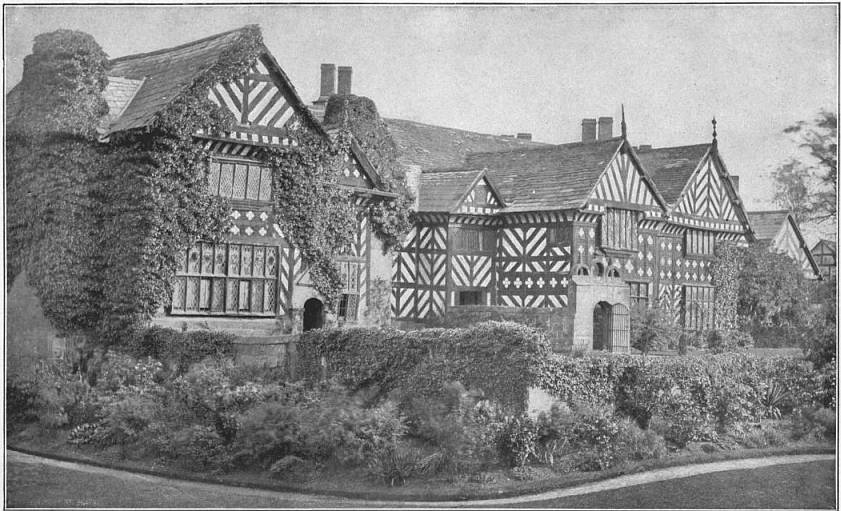 |
| Photo, Frith & Co. |
| Fig. 10.—SPEKE HALL, NEAR LIVERPOOL. |
 |
| Photo, F. Frith & Co. |
| Fig. 11.—MORETON OLD HALL, NEAR CONGLETON, CHESHIRE. |
Plate IV.
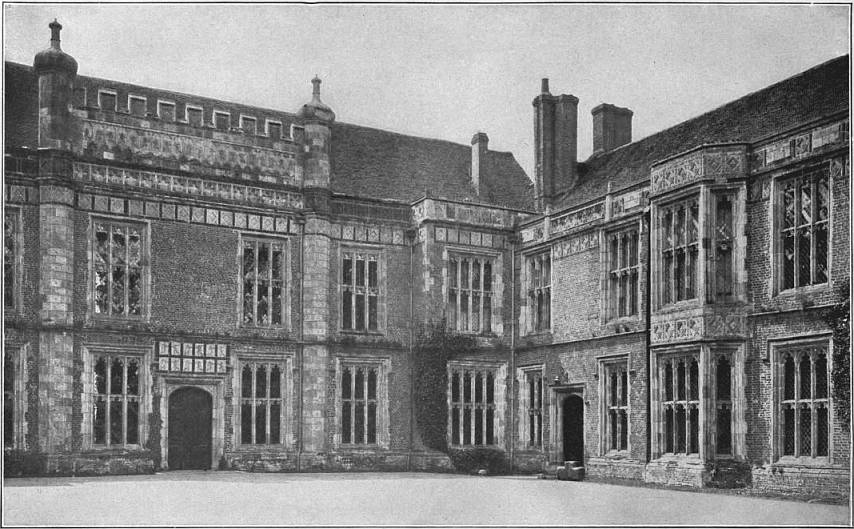 |
| From Garner and Stratton, Domestic Architecture of England during the Tudor Period, 1910. By permission of B. T. Batsford. |
| Fig. 12.—SOUTH COURT OF SUTTON PLACE, SURREY, 1525. |
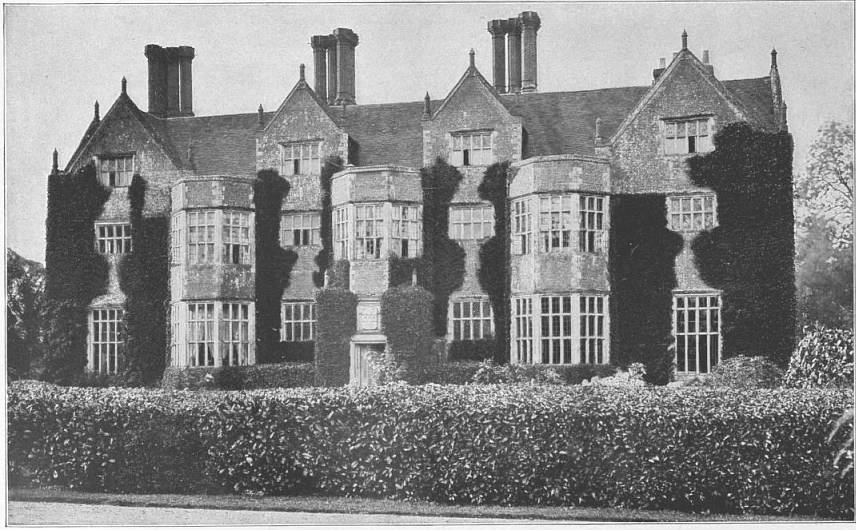 |
| From Gotch, Architecture of the Renaissance in England, 1894. By permission of B. T. Batsford. |
| Fig. 13.—MOYNS PARK, ESSEX, 1580. |
Plate V.
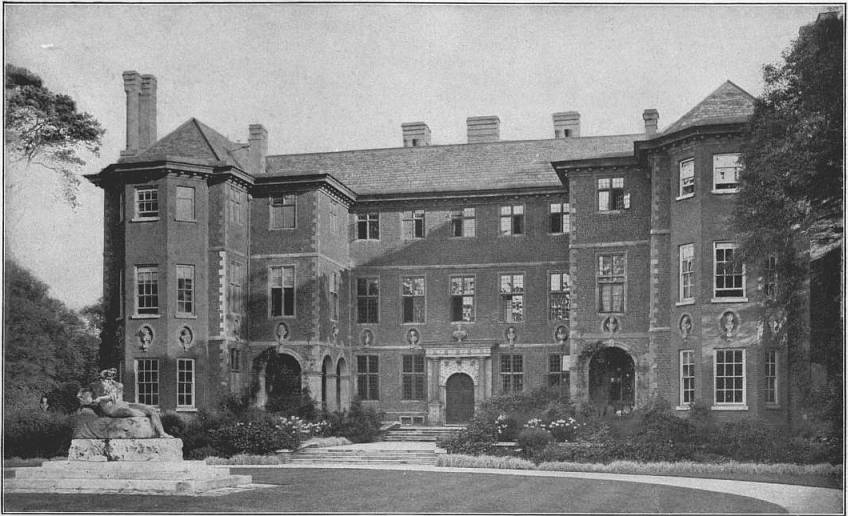 |
| From Belcher and Macartney, Later Renaissance Architecture in England, 1901. By permission of B. T. Batsford. |
| Fig. 14.—HAM HOUSE, PETERSHAM, 1610. |
 |
| From Gotch, Architecture of the Renaissance in England, 1894. By permission of B. T. Batsford. |
| Fig. 15.—BRAMSHILL, HAMPSHIRE, 1612. |
Plate VI.
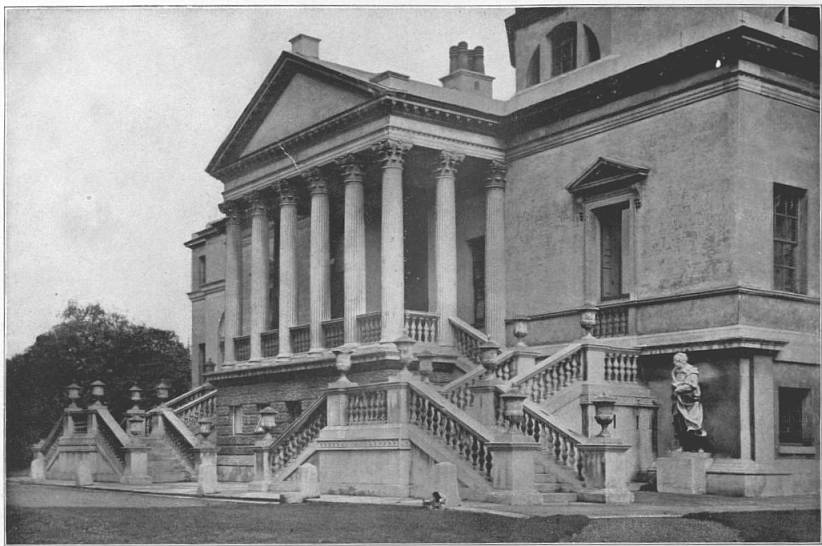 |
| From Belcher and MaCartney, Later Renaissance Architecture in England, By permission of B. T. Batsford. |
| Fig. 16.—THE EARL OF BURLINGTON’S VILLA, CHISWICK. EIGHTEENTH CENTURY. |
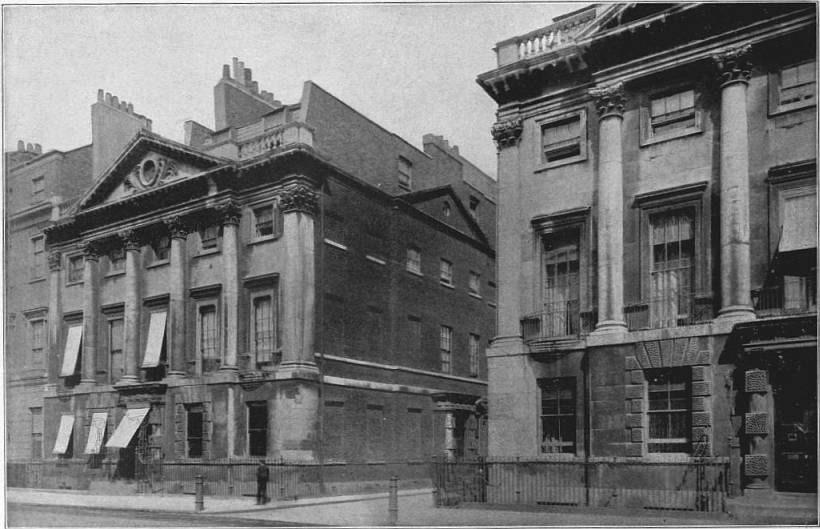 |
| From the same source as above. |
| Fig. 17.—HOUSES IN CAVENDISH SQUARE, LONDON. EIGHTEENTH CENTURY. |
Perhaps in one respect the greatest change which has been made in the English house is the adoption of “flats”; commenced some time in the ’fifties in Ashley Gardens, Westminster, they have spread throughout London. In consequence of the great value of the sites on which they are sometimes built, to which must be added the cost of the houses pulled down to make way for them, the question of expense in material and rich decoration has not always been worth considering, so that frontages in stone, with the classic orders brought in with many varieties of design, have given the character of a palace to a structure in which none of the rooms exceeds the modest height of 10 ft. The increasing demand for these, however, shows that they meet, so far as their accommodation and comfort are concerned, the wants and tastes of the upper and middle classes. In some of the London streets, where shops occupy the ground floor, a far finer type of house has been erected than that which could have been afforded for the shopkeeper’s residence above, as in old times, so that London promises in time to become a city of palaces. The same change in the aspects of its streets has long been evident in Paris, but there is one feature in the latter city which has never yet found its way into London, much to the surprise of French visitors, viz. the porte-cochère, through which the occupants of the house can in wet weather drive and be landed in a covered hall or vestibule. This requires, of course, a small court at the back, so small that one wonders sometimes how it is possible for the carriage to turn round in it. The porte-cochère also, from its dimensions, is a feature of more importance than the ordinary street doorway, even when a portico of some kind is added; on the other hand, the strict regulations in Paris as regards the projection of cornices and other decorative accessories gives to the stranger the appearance of monotony in their design, which certainly cannot be said of the houses in flats lately built in London. Within recent years an old English feature, known as the bow-window, has been introduced into Paris, the primary object of which does not seem yet to have been thoroughly understood by the French architect. An English bow-window, by its slight projection in front of the main wall, increases greatly the amount of light entering the room, and it is generally placed between solid piers of stone or brick. The French architects, however, project their piers on immense corbels, and then sink their windows with deep external reveals, so that no benefit accrues to the room, so far as the increased light is concerned. In Paris, since 1900, there has been a tendency to introduce a style of design in French houses which is known as “l’art nouveau,” a style which commenced in furniture as a reaction against the revival of the Empire and Louis XIV. and XVI. periods, and was then extended to house fronts; this style has unfortunately spread through the various towns in France and apparently to Germany, again as a reaction against the formal classic style of the latter half of the 19th century. It is probable that in Italy and Spain “l’art nouveau” may meet with the same success, and for the same reasons, so that in the latter country it will be a revival, with modifications, of the well-known Churrigueresque style, the most debased Rococo style which has ever existed. In England it has never met with any response.
1 A complete description of these houses will be found in The Evolution of the English House, by S. O. Addy.


